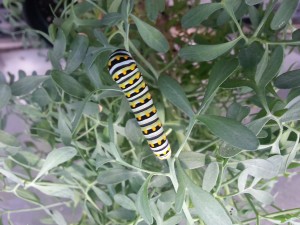“Night terrors” have taken on a whole new meaning for me. Around 2am I was awoken to the feeling of something squirming and fluttering…in my ear. You better believe I screamed loud enough to wake both my roommate and
neighbors up. I reached into my ear and the creature squirmed further in to where I could no longer reach or see it. Even just typing these words down and remembering the feeling of something making its way down my ear canal gives me goosebumps. The feeling was one of the strangest (and most horrifying) things I have ever experienced.

American Cockroach Taken by Brockett Film Fauna, Inc.
I couldn’t see it or feel it, but I knew it was in there. And it needed to come out. Naturally, I turned to Google, which suggested flushing my ear out with mineral water or baby oil. I didn’t have either of those, but the next best thing was tap water. I flushed my ear out several times until the insect finally spewed out. It fell to the floor and I immediately captured it. To my surprise and horror, it was not a small beetle or tiny fly—it was an American cockroach (Periplaneta americana)!!
Upon telling my story to my friends the next day, I got many comments such as, “No way! That’s an old wives’ tale!” and “You’re lucky it didn’t lay its eggs there!” Upon doing research, however, I found some interesting details. First of all, it is not an old wives’ tale—many hospitals in big cities remove many cockroaches from patients’ ears a week! I also realized that I was extremely lucky—most cockroaches that go into peoples’ ears are caught too late, causing excruciating pain and a trip to the emergency room. Due to my prompt reaction and the small size of the cockroach, I was able to get it out without enduring pain or visiting the ER.
So why do cockroaches travel into your ear canal? Is it really to lay their eggs there? Or to feed on your brain?!
Cockroaches, as it turns out, do not go in search of a human ear to use as a nest or in search of delicious brain food. According to Chris Williams, “Cockroaches end up in ears because they literally stumble upon them during their wanderings,

Cockroach Near Ear Canal by Emma Edwards
and being cockroaches who like small, dark spaces, they check it out.” So, a curious cockroach travels up into your ear canal as it seems like a suitable environment to live. They soon learn, however, that a waxy and tiny canal is not the best place for survival. Why, then, do they stay there? Why don’t they just leave?
Apparently, cockroaches are too wide to turn around in the narrow ear canal. Additionally, according to Chris Williams,“They’re not so good at the concept of backing out”. Thus, instead of just going in reverse to get out of the ear, they tend to burrow further into the ear canal and will eventually get stuck there.
Is it just adventurous cockroaches that get stuck in peoples’ ears? The answer, unfortunately, is no. According to Dr. Barrie Tan, he has seen many insects, from ants and moths to even bees, stuck in peoples’ ears before. Yuck!
If this ever happens to you, remember: DON’T try and get it out with a Q-tip or tweezers! According to this case study, doing so can cause cerumen (earwax) impaction as well as crushing the insect, making it harder for it to get out. Just try flushing it out with oil or mineral water, and if that doesn’t work , go to the ER.
For more information about American cockroaches and they’re mischievous activities, click here.



















